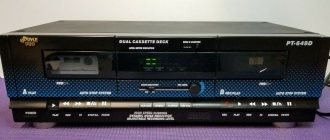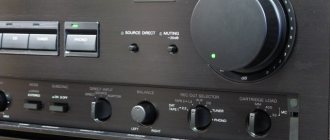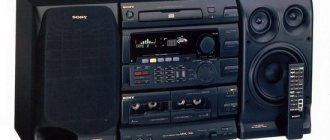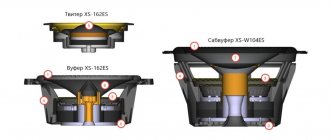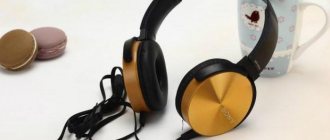What you need to replace the drivers in the Sony K808ES deck
- Phillips screwdrivers with large and small heads;
- flat screwdriver;
- thin tweezers;
- rope or thin wire for tightening the belt
- flat and square belts from the set “Mode belt 3-356-603-01 for SONY”
The square belt that wears out most often is a square belt; similar belts are installed in the eject mechanism of the CD/DVD disc tray of computer DVD drives; the size of the belt is approximately 32 mm.
Passenger sizes: Flat 109x4x0.6mm (flat belt) link : suitable belts on Aliexpress Square 32x1.2x1.2mm (square belt) link : suitable belts on Aliexpress
The belts are also suitable for the following deck models: TC-KA2ES TC-KA3ES TC-KA6ES TC-K222ESL TC-K222ESA TC-K333ES TC-K808ES TC-K850ES TC-K870ES TC-K890ES TC-K909ES TC-K950ES HCD-541 DVP-CX777ES CD Player.
Passenger sizes for Sony TC-K808ES:
Flat 109x4x0.6mm (flat belt) link: suitable belts on Aliexpress Square 32x1.2x1.2mm (square belt) link: suitable belts on Aliexpress
table of belts for all imported decks and not only belt sizes! https://russellind.com/client/download/PRB_Belt_XRef.pdf FRW8.5 SCQ2.5 Everything is simple there. SANYO - RD-W89 - look at the line in the column PRB replacement - this is FRW9.1 Look at the end of the document FRW9.1 circumference 9.1 height 0.155 thickness 0.020 values in inches, take a calculator, count - 1 inch = 25.4 mm circumference 231 mm (115.5 mm half-length) height 3.9 mm thickness 0.5 mm Dimensions must be multiplied by 25.4 to get in millimeters, and the circumferential length must also be divided in half to get half-length
History of Sony audio equipment
In September 1945, after the end of World War II, Masaru Ibuka opened a radio repair shop in the bombed Shirokiya department store building in Tokyo's Nihonbashi district. Ibuka was making short-wave adapters that could easily convert medium-wave radios into superheterodyne or all-wave receivers. The demand for such radio stations grew rapidly.
That same Shirokiya department store In 1946, Akio Morita saw a newspaper article about the new enterprise of his colleague Ibuki and, after some correspondence, decided to join him. With 20 employees and an initial capital of 190,000 yen, the partners founded Tokyo Tsushin Kogyo KK , or Totsuko - Tokyo Telecommunications Engineering Corporation, on May 7, 1946. Soon after its founding, the Morita family, which was involved in the production of sake, miso and soy sauce, invested in Sony and became the largest shareholder.
This Japanese company would later invent the Walkman, the compact disc, the PlayStation, and even buy a Hollywood film studio. But they started with the production of an ordinary megaphone and a rice cooker, which was so-so, but in post-war Japan they were not particularly picky.
1950
Totsuko's first true audio product was the Type-G reel-to-reel tape recorder, released in 1950, but it was unlikely to be successful due to its bulkiness and unrealistic price of more than 40,000 yen at the time.
But the Japanese were lucky - a shortage of stenographers in the district court saved the company. Themis needed devices for voice recording. An order for 24 tape recorders brought Ibuki and Morita's business 1 million yen. It's funny that the tape for him was called "SONI-TAPE".
Despite the failure, the tape recorder was not abandoned, and after some time the H-type recorders and the P-type consumer model were released, which became commercially successful.
In the early 1950s, Ibuka learned about the invention of the transistor at Bell Labs. He convinced Bell to license the technology to Tokyo Tsushin Kogyo. While most Japanese companies were trying to use transistors for military purposes, Ibuka and Morita decided to use them in radios. And although the American companies Regency Electronics and Texas Instruments created the first transistor radio, it was Ibuki's company that first made transistors commercially successful.
Already in August 1955, the Japanese launched the first commercial transistor radio receiver TR-55, which they began selling under the new brand name Sony . However, Tokyo Tsushin Kogyo did not officially change its name to Sony until January 1958, and used it only as a trademark.
The name Sony was chosen for the brand as a combination of two words: one was the Latin word "sonus", meaning sound, and the other was "sonny", a slang term used in the 1950s for boys. In the 1950s in Japan, the English word "Sonny boys" was borrowed to mean the smart and presentable young men that founders Akio Morita and Masaru Ibuka considered themselves to be.
In December of that year, they released the Sony TR-72, a receiver that gained popularity in export markets including Canada, Australia, the Netherlands and Germany. Featuring six transistors, push-pull output, and vastly improved sound quality, the TR-72 continued to be popular well into the early sixties.
In May 1956, the company released the compact TR-6 receiver, which featured an innovative slim design and sound quality that rivaled portable tube radios. The following year, 1957, Tokyo Tsushin Kogyo released the TR-63, at that time the smallest (112 × 71 × 32 mm) transistor radio in the world. It was a worldwide commercial success.
The TR-63 was the first Sony product sold in the United States. Funnily enough, the device was too big to fit in a shirt's breast pocket, so the company gave sellers shirts with large pockets so they could legally claim it was the world's first pocket transistor radio.
As a result, the TR-63 cracked the US market and launched a new consumer microelectronics industry. By the mid-1950s, American teenagers began purchasing portable transistor radios in huge quantities, propelling the nascent industry from about 100,000 units in 1955 to 5 million units by the end of 1968.
1960
Inspired by the popularity of their devices, in 1960 the Japanese opened Sony Corporation of America. The Sony brand quickly helped dispel the image of Japanese products as being of poor quality. This, in turn, allowed the company to maintain high prices.
In the same year, Sony released the first all-transistor portable TV TV8-301 with a screen diagonal of 20 cm, which included 23 silicon and germanium transistors, 17 diodes, two of which were high-voltage. Plus it had a compartment for two 6-volt lead-acid batteries. The television was expensive because it was innovative in many ways, so for the average consumer it was a luxury item rather than a practical purchase. He was also "breakable", which led to him being nicknamed "the fragile little child". It was discontinued in 1962.
In 1965, Sony released the world's first integrated stereo amplifier, the TA-1120, built entirely on silicon transistors. This was the first product in the ES series (by the way, read my post about the history of the ES series). The device caused a sensation throughout the audio industry due to its ability to offer what tube amplifiers could not: high output power while delivering low distortion.
1970
In 1970, the company released the TC-9000 audiophile reel-to-reel tape recorder, using single-sided 2-track stereo recording instead of conventional 4-track stereo recording at a tape speed of 38 cm per second (about double that of traditional models). This ensured the highest quality, similar to professional equipment.
In 1973, the first Densuke cassette recorder, the TC-2850SD, was released. Although this tape recorder was portable, it provided very high quality and was also used as a stationary model.
In subsequent years, Sony released a whole galaxy of similar recorders of different sizes. Which ultimately, in 1978, led to the creation of the legendary reporter recorder TC-D5, which was produced for more than 20 years. But the most interesting thing happened after.
In 1978, the already elderly Masaru Ibuka asked to develop a more compact version of the cassette player, which he could use during air travel. The prototype was assembled on the basis of the TCM-600 reporter voice recorder, and it so impressed the board of directors, Morita and Ibuka himself that it was immediately put into production.
Walkman prototype
This is how Sony changed the world of music forever. Between the release of the first Sony Walkman on July 1, 1979 and its final incarnation in October 2010, more than 385 million units were sold. The Walkman not only changed the way we consume music and elevated the compact cassette to the Olympus of audio technology, but also gave birth to an entirely new niche of portable headphones
It should be noted that in parallel, in 1977, Sony released a strange device, the PCM-1. The device allowed users to digitally record by connecting to a home VCR. This device played a significant role in the history of audio, as even amateurs were able to use PCM technology, which was previously only available to professionals. This technology would eventually lead to the development of the compact disc.
The digital PCM-1 looks even more impressive given the fact that Sony has been churning out monster receivers like the STR-7800 over the years, which are nothing short of epitomizing the analog era.
1980
The early 1980s were a difficult time for the electronics industry. According to some, the Sony star has been hit hard by the global economic downturn. But instead of downsizing, new president Norio Oga decided to continue developing the revolutionary compact disc format
As a result, in June 1980, Sony and Philips unveiled a new standard, and a year later Sony showed its famous prototype of the Goronta CD player, which marked the beginning of the triumphant march of the CD across the planet.
In the same year, the first 2000 copies of the legendary MDR-R10 headphones were released, which are still considered the standard for both sound and engineering quality. The strange-looking ear cups are made of zelkova and the ear pads are made of lambskin. Some audiophiles call the R10, no less, the best headphones in the world.
And so, returning to CDs, on October 1, 1982, the world's first consumer CD player, the CDP-101, went on sale in Japan for a list price of 168,000 yen (about $730), opening new audiophile horizons. Due to the high cost of digital-to-analog converters at the time, the CDP-101 only had one DAC for the left and right channels. It did not have a sample-and-hold circuit to delay one channel until the other was processed, so the left and right channels were about 11 µs out of sync.
In 1984, the Discman D-50 portable CD player once again changed the landscape of portable audio. People all over the world are starting to carry CD players with them, but due to the lack of anti-shock, this has to be done very carefully.
In 1987, Sony introduced the DAT digital audio cassette format. They can be recorded at sampling rates equal to or even higher than CD (44.1, 48, or 32 kHz sampling rates) with 16-bit quantization. If you copy a digital source onto DAT, it will be an exact clone, unlike Philips DCC tapes, which use a data reduction system.
In the 1980s, the company made some of its most beautiful devices, in almost every line from budget radios and stereo systems to audiophile ES components.
1990
Sony announced the MiniDisc in September 1992 and released it in November of that year for sale in Japan, and in December in Europe, Canada, the United States and other countries. MiniDisc was a progressive magneto-optical disc format providing 60, 74, and then 80 minutes of digitized audio or 1 gigabyte of Hi-MD data.
Sony brand minidisc devices appeared on the market in September 1992. Sony continued to develop them for a long time, selling the last of the players in March 2013. Despite Sony's firm belief that MiniDisc, a format offering CD quality with the (recording) functionality of a cassette, would be the Next Big Thing, it was unceremoniously destroyed by the advent of the mp3 and the popularity of the upstart Cupertino gadget.
The end of the decade for audiophiles was brightened by the emergence of SACD, introduced by Sony and Philips in 1999. The SACD format offered more audio channels (such as surround sound), higher bit rates, and longer playback times than regular CDs.
The audiophile player Sony SCD-1 was introduced at the same time as the SACD format in 1999 at a price of about $5,000. It weighed over 26 kg and played only two-channel SACD and Orthodox CDs. They are so good that audiophiles around the world are still chasing them.
SACDs did not achieve the same level of growth as compact discs in the 1980s and were not adopted by the mass consumer. By 2007, SACD had failed to make a significant impact in the market as consumers increasingly downloaded low-resolution music files over the Internet and purchased little physical music. A small SACD market remained only for audiophiles.
2000 – present day
After the death of Masaru Ibuki in 1997 and Akio Morita in 1999, the company stopped concentrating on serious audio equipment. However, in 2008, the Japanese introduced the world to the amazing Soutina NSA-PF1 speaker system, which emits sound using a vibrating plexiglass tube. The price of $10,000, of course, did not allow these speakers to spread into audiophile homes, and the Soutina remained a concept.
Another noteworthy device in my opinion that had the right ES series DNA was the HAP-Z1ES digital player, which won the EISA award for Best Digital Source in 2014-2015. And although he was praised for his excellent sound, for some reason he never received much recognition from the masses.
While everyone began to forget about the audiophile exploits of the company, the Japanese were able to demonstrate that the company still respects tradition and does not forget about the highest quality audio equipment. Among the latest audiophile devices, one cannot fail to note the amazing DMP-Z1 player, which I talked about not long ago, and the MDR-Z1 headphones. These are truly great devices with the highest sound quality.
And although Sony these days has stopped making audio equipment that can radically change the course of history, the company can still create amazing things that can impress. I'm sure we'll see more audiophile products with the Sony logo that will take our breath away. But will they change the course of history as before?


